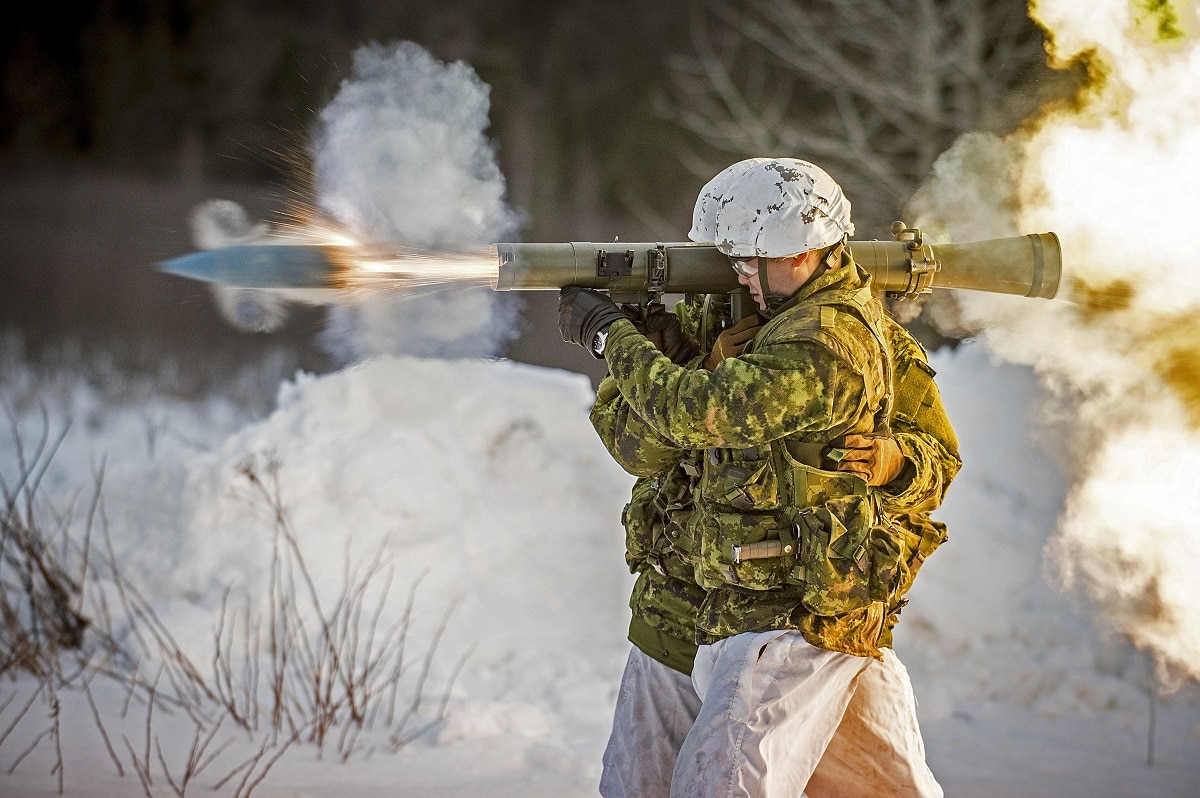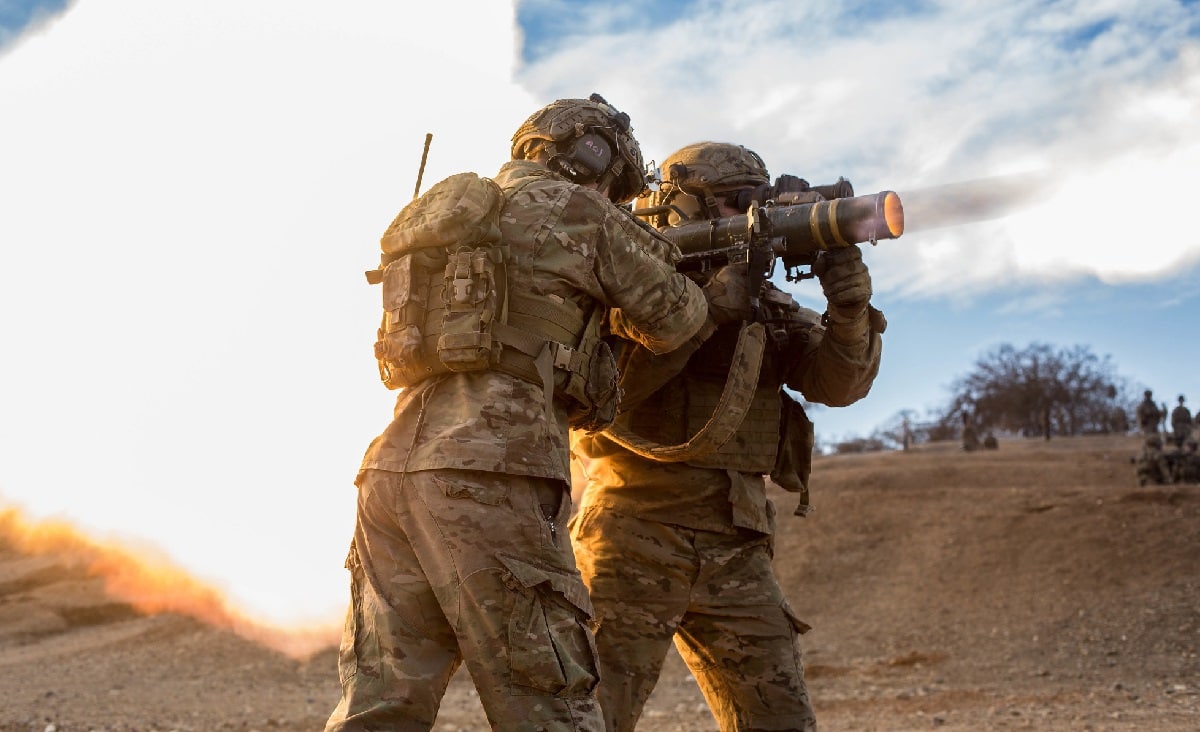Meet the Carl Gustaf: As I noted in previous articles on the Saab 35 Draken fighter plane, Saab 37 Viggen fighter, and A-36 bomber, Sweden’s policy of neutrality during the Cold War didn’t stop that Scandinavian nation from developing some top-notch military hardware for the sake of being properly prepared in case neutrality failed.
This embodied the 7 Ps Principle: Proper Prior Planning Prevents P*$$ Poor Performance. Swedish military designers’ proper preparatory prowess wasn’t strictly limited to airpower either, as can be seen from infantry weapons such as the Granatgevär “grenade rifle”) m/48, better known to the English-speaking world as the Carl Gustaf 84mm recoilless rifle, which has been going strong since its invention in 1946.
The Infantryman’s Hammer of Thor
Though it hasn’t yet racked up as big a kill tally in the Russo-Ukrainian conflict as, say the TB Bayraktar drones or the Javelin missile, the Carl Gustaf has certainly made its own big splash in the ongoing war (or “special military operation,” as Putin insists upon labeling it). This has graphically demonstrated via weapon’ recent usage by Ukraine’s Kharkiv Territorial Defense Forces to destroy a T-90M main battle tank, arguably the most sophisticated MBT that the Russians have deployed in the invasion. Ukraine’s opportunistic Ministry of Defence seized upon the moment to post video footage of this tank kill on Twitter, with the headline: “Near Stary Saltiv,Kharkiv Territorial Defense fighters eliminated another new T-90M “Breakthrough” tank. The pride of the russian tank industry was destroyed by the Swedish hand-held anti-tank grenade launcher Carl Gustaf.We thank the Swedish people and the King for their help.”
In other words, if you’ll forgive the bad pun, this Swedish Hammer of Thor has proven itself—in terms of both physical destructiveness and propaganda points—to be quite a Thor(n) in the side to Russian armor.
To give our readers a greater appreciation of how impressive this Ukranian achievement is—and why it’s such an embarrassment for the Russian defense industry—let’s take a look at the T-90M’s supposedly superior survivability, courtesy of my 1945 colleague Harrison Kass:
“The upgraded T-90M has improved armor over the original. Whereas the T-90 was encased in Kontakt-5 armor, the M-variant uses Relikt built-in Explosive Reactive Armor (ERA). ERA is designed to provide protection against tandem warheads, and reduce the likelihood of penetration from armor-piercing fin-stabilized discarding sabot (APFSDS) rounds. The T-90M also features rubber side skirts with additional armor plating; Cage armor, special netting; and spall lining are used to supplement the tank’s protection. For the sake of the crew and internal equipment, the tank uses an NBC system, which uses tank interior sealing and overpressure generation to protect against mass destruction weapons. The T-90M also features a clever countermeasure system: smoke grenade dischargers triggered when a laser beam sights the tank, making the tank a more elusive target.”
Yet all for naught when hit by the Carl Gustaf’s 84mm round. Which in turn begs the question: what makes the Carl Gustaf so deadly?
King Carl’s Namesake
In the aforementioned Twitter post, the “King” that the Ukrainian MoD was referring to is the current Swedish monarch, Carl XVI Gustaf. The weapon itself was indeed named after one of his ancestors, Carl X Gustav, who conferred naming privileges upon the weapon’s original manufacturer, Carl Gustafs Stads Gevärsfaktori (“Rifle Factory of Carl Gustaf’s Town”). Now in its fourth iteration, the M4—or M3E1 Multi-Role Anti-Armor Anti-Personnel Weapon System (MAAWS) in U.S. military nomenclature (presumably to avoid confusion with the M4 carbine—the weapon is currently manufactured by Saab Bofors Dynamics.
Originally inspired by WWII antitank weapons such as the American Bazooka and Wehrmacht Panzershreck, the m/48 certainly hasn’t remained frozen in time. Indeed, the current iteration M4 displays continuous improvements such as a titanium-lined barrel. In addition, improved ergonomics have resulted in mating Picatinny rails to the barrel for better customization, and a slightly more compact weapon that aids maneuverability in confined, urban spaces, and has the additional benefit of further reducing the Carl Gustaf’s weight. The M4 updated variant weighs a far more user-friendly 15 pounds, down from the original M1 design’s 31 pounds; although the single-shot AT4 is lighter and can be carried by one person, a Gustaf team with the heavier recoilless rifle can reload and fire more rounds.
More significantly from the lethality standpoint, Ol’ King Carl has a wide range of ammunition that is available for the platform, steadily updated to address advances in armored vehicle design. Though I have not yet been able to determine the specific ammunition type that the Ukrainians have been using for their Gustafs, more than likely it is either the FFV551 HEAT (High Explosive Anti-Tank) or the FFV651 HEAT round, the latter of which includes a stand-off probe for the fuse to improve performance against reactive armor.

U.S. Marine Corps Lance Cpl. Hunter Cross, a native of Midlands, Mich., and a combat engineer with 2d Combat Engineer Battalion, 2d Marine Division, fires an M3E1 multipurpose anti-armor anti-personnel weapon system (MAAWS) on Camp Lejeune, N.C., Dec. 9, 2021. The MAAWS, also known as the Carl Gustaf, is a man-portable, reusable, breech-loading, 84 mm recoilless rifle capable of destroying armored targets. (U.S. Marine Corps photo by Lance Cpl. Brian Bolin Jr.)

Carl Gustaf Firing: Sky Soldiers from 1st Battalion, 503rd Infantry Regiment engaged targets with the Carl Gustaf 84mm weapon system in Grafenwoehr, Germany September 8, 2018 during Saber Junction 18. Exercise Saber Junction 18 is a U.S. Army Europe-directed exercise designed to assess the readiness of the U.S. Army’s 173rd Airborne Brigade to execute unified land operations in a joint, combined environment and to promote interoperability with participating allies and partner nations.

Image: Creative Commons.

Australian soldiers assigned to 5th Battalion, Royal Australian Regiment fire an 84 mm M3 Carl Gustave rocket launcher at Range 10, Pohakuloa Training Area, Hawaii, July 20, 2014, during Rim of the Pacific (RIMPAC) Exercise 2014. (U.S. Marine photo by Sgt. Matthew Callahan/Released).

Sky Soldiers from 1st Battalion, 503rd Infantry Regiment engaged targets with the Carl Gustaf 84mm weapon system in Grafenwoehr, Germany September 8, 2018 during Saber Junction 18. Exercise Saber Junction 18 is a U.S. Army Europe-directed exercise designed to assess the readiness of the U.S. Army’s 173rd Airborne Brigade to execute unified land operations in a joint, combined environment and to promote interoperability with participating allies and partner nations.

Carl Gustaf Recoilless Rifle in action with Canadian forces.

U.S. Army Rangers assigned to 2nd Battalion, 75th Ranger Regiment, fire off a Carl Gustav 84mm recoilless rifle at a range on Camp Roberts, Calif., Jan 26, 2014. Rangers use a multitude of weaponry during their annual tactical training.

Australian soldiers assigned to 5th Battalion, Royal Australian Regiment fire an 84 mm M3 Carl Gustave rocket launcher at Range 10, Pohakuloa Training Area, Hawaii, July 20, 2014, during Rim of the Pacific (RIMPAC) Exercise 2014. (U.S. Marine photo by Sgt. Matthew Callahan/Released)

A coalition force member fires a Carl Gustav recoilless rifle system during weapons practice on a range in Helmand province, Afghanistan, Feb. 16, 2013. Coalition force members test fire various weapons systems on the range to check accuracy. (U.S. Army photo by Sgt. Benjamin Tuck/Released)
Carl Gustaf’s Shots Heard ‘Round the World
Besides the Americans and the Ukrainians, there is a veritable laundry list of nations—47 at last count—around the world who have armed their militaries with the Carl Gustav, spanning the globe and the alphabet from Argentina to Zambia. The Aussies in particular have jokingly nicknamed it “Charlie Gutsache,” i.e. guts ache or stomach pain…and Russian tankers would undoubtedly agree with that moniker.
Christian D. Orr is a former Air Force officer, Federal law enforcement officer, and private military contractor (with assignments worked in Iraq, the United Arab Emirates, Kosovo, Japan, Germany, and the Pentagon). Chris holds a B.A. in International Relations from the University of Southern California (USC) and an M.A. in Intelligence Studies (concentration in Terrorism Studies) from American Military University (AMU). He has also been published in The Daily Torch and The Journal of Intelligence and Cyber Security.

